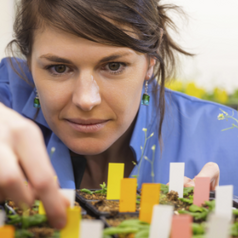Plant researcher Dr. Elke Barbez is a new member of CIBSS. For the 2022 International Women's Day on March 8, 2020, she gave a special interview and talked to Mathilde Bessert-Nettelbeck about her research, signalling science and gender equality. At CIBSS, she is leading the CIBSS-B project “The inter-regulation of extracellular matrix charge and nutrient availability in the root”.


International Women's Day Special: Interview with Dr. Elke Barbez
The CIBSS plant researcher explains her research on cell walls and talks about signalling and gender equality

“I'm always amazed about the ability of plants to create so much biomass, just out of water, carbon dioxide and light.”
Elke Barbez
What do you like about plants?
Elke Barbez: Every spring and summer, I'm growing plants on the balcony and in the garden. I'm always amazed by the ability of plants to create so much biomass, just out of water, carbon dioxide, and light.
Your research topic is the extracellular matrix. What is it exactly in plants? Why is it important?
The extracellular matrix is actually part of the plant, but it is not part of the plant cells. In other words, it is the space between the cells. In plants, this space is occupied by the cell wall, which is made up of a complex mixture of big polymers. The cell wall is essential for plants because it provides strength and rigidity. It enables the plants to grow really high. Think of the highest trees in the world, the giant sequoia trees. In German, they are called Riesenmammutbaum. They get up to 100 meters high!
The most important building block of the cell wall is cellulose. We all know cellulose from our daily lives, since most paper is produced from cellulose, and paper production is the main commercial use of this fiber. The second most important building block of the cell wall is pectin. It consists of very long molecules that wrap around cellulose and keep the cellulose together to make the whole cell wall even stronger. You probably know pectin as a binder and gelling agent for marmalade.
What is very interesting about pectin, is that it carries chemically charged groups, and these charges are always negative. My research interest lies exactly in these negative charges on the pectin in the cell wall. We know that the plant can change the degree of charge in the cell wall according to its needs. We also know that several important mineral nutrients required by plants are positively charged, such as calcium, potassium, and iron. You can imagine the plant root as a big magnet that collects the nutrients it requires during its growth through the soil. I want to find out how plants use and alter the cell wall charge in their roots to optimize their nutrient uptake, so they can grow better in nutrient poor soils.
Dr. Elke Barbez, Group leader at CIBSS
- 2013 PhD Thesis, Ghent University, Gent (Belgium).
- 2014 to 2016 Postdoctoral researcher at the Gregor Mendel Institute, Vienna (Austria)
- 2016 to 2018 Parental leave, part-time employment at the Viennese Gregor Mendel Institute (GMI) and BOKU
- 2018 to 2019 Project leader at the department of applied genetics and cell biology, BOKU (Austria)
- 2019 to 2020 Parental leave, part-time employment at BOKU, Vienna (Austria)
- 2020 to 2021 Project leader BOKU, Vienna (Austria)
- Since 2021 Junior group leader at Institute of Biology II, University of Freiburg (Germany) and member of CIBSS
You started in CIBSS at the end of last year. CIBSS projects revolve around biological signalling on various scales and organisms. What makes signalling such an essential topic of biology?
In biology, signalling describes the transmission, perception, and processing of information. In the case of my research, the signal would be the amount of specific nutrients in the soil which could be sensed by the plant. The signal needs to be transmitted, perceived, processed, and reacted to, so the plant can adapt itself to grow optimally in its current nutrient environment.
Understanding this signalling activity is very powerful, since it will allow us to modulate this process to improve plant adaptation to certain growth environments. With the knowledge that we acquire, we could contribute to the development of plants that grow well with less or without synthetic fertilizers. Additionally, I would like to mention: if I talk about “developing” plants, this is possible via genetic engineering, but it can be also be done via classical breeding technologies.
I saw on your website that you work with a method called genome wide association study. Can you tell me what exactly this is and how you use it?
Yes, genome wide association studies, or as we call it shortly, GWAS is actually a powerful tool that substantially gained importance since technologies for next generation sequencing became relatively easy and affordable. GWAS compare the genomes, meaning the entire genetic sequence, of a group of individuals with a certain characteristic with or without it, to identify the genomic region that is responsible for this characteristic. In my project, we compared genomes of plants ecotypes that originated from soils with sufficient nutrients to plant ecotypes used to grow on nutrient poor soil. This enabled us to identify genes that may help plants to adapt better to growth environments with either many or few nutrients. Strikingly, I identified some genes that regulate the charge of cells. So out of this GWAS screen and analysis, my passion for cell wall charge was born. So that is where this project actually started.
CIBSS is a lot about cooperation between different areas of signalling studies. Which new cooperations are you looking forward to?
I totally embrace the cooperative atmosphere within CIBSS, which made it possible to quickly establish several important collaborations with very nice people. But if I have to choose one collaborator, it is one that I have met very recently for the first time on the stairs on my way out for lunch: Barbara Di Ventura. The group of Barbara preprinted a new in silico tool – meaning a computer-based method – last week, which is called patcHwork. This tool is able to predict the charged patches on proteins in a pH-dependent manner. When I saw this, I thought this is so cool! So I tried it right away. The good thing about this tool is that you only need the digital structure of your protein. You can stay at your computer. For the plant community, that is a very important development: The pH in the cell wall is very dynamic and there are many proteins. We can now identify proteins that interact with the cell wall in a pH-dependent matter. In that context, I am looking forward to collaborating with Mehmet Ali Öztürk and Mirko Schmitz from Barbara Di Ventura’s lab.

Dr. Elke Barbez
“As I see it, for every man that is not taking parental leave, or cannot take parental leave, there is a partner at home that cannot pursue their career.”
What do you personally think is the most urgent measure in regard to gender equality and diversity in research and the university?
I believe that issues that resolve around gender equality and diversity are a concern to us all, both women and men. And I therefore believe that at universities, it is very important to support both, women and men, to take parental leave. For every man who is not taking parental leave, or cannot take parental leave, there is a partner at home who cannot pursue their career.
A second aspect, which is important to me, is the assessment of how equality and diversity measures are implemented at the university. It is great to read a lot of strong and good statements on gender equality and diversity issues on websites, but it is also essential to look into the individual labs, different faculties, and in everyday life to see if these objectives are indeed being put into place.



